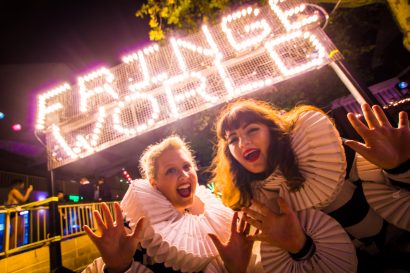Martu artist Bugai Whyoulter brings her first solo show in eight years to FORM in Claremont, writes Stephen Bevis.
As the grey winter rain beats down on The Goods Shed’s tin roof, vivid colours radiate in rhythmic harmony from the white walls of FORM’s gallery inside.
The western desert art of Bugai Whyoulter has come to brighten up the bleak depths of a Perth winter, the first solo show by this acclaimed Martu artist in eight years.
Many of the 40 dynamic acrylic-on-canvas works at FORM’s Claremont art space spring from a prolific burst of painting inspired by Whyoulter’s recent return to Country, the undulating red sands and waterholes around Wantili (Well 25 along the Canning Stock Route in the Great Sandy Desert).
This important ceremonial site is where Whyoulter, now about 80, first encountered Europeans for the first time as a teenager. It’s where she and her grandson Cyril Whyoulter, who also paints with the esteemed Martumili Artists group, spent time painting together last year in an important act of cultural transmission between generations.
A joint finalist in next month’s annual Telstra National Aboriginal and Torres Strait Islander Art Awards, Whyoulter is among a declining number of ‘pujiman’ or desert-born Martu artists who maintained an entirely independent, nomadic desert lifestyle until the 1950s and 1960s.
“Bugai always tells about Wantili,” Cyril Whyoulter says of his grandmother, a Warnman and Kartujarra speaker whose dynamic paintings pulsate with power across languages and cultures. “She saw whitefellas there for the first time. . . Canning mob travelling up and down the stock route with their bullocks . . . (her people) ran away from the whitefellas, watching them from a long distance.”
Her family eventually settled at Parrngurr on the edge of the Karlamilyi (Rudall River) National Park and then Jigalong until 2002 when the Martu’s successful land claim initiated her return to her homeland and the community of Kunawarritji near Well 33.
She took to painting relatively late in 2007, working her creative practice initially in textiles (a wall installation of 22 eye-popping minarri grass and wool baskets dazzles against a black background at the rear of the gallery). She adapted to painting under the influence of the Two Noras, the late renowned Martumili matriarchs Nora Nungabar and Nora Wompi with whom she shared a house for many years.
Bound by kinship and country, the three women embodied the Martu approach to painting, ‘kutjanka’, which translates in desert language as “together as one”. Surrounded by grandchildren and their favourite dogs, their art-making was social, collaborative, prolific and pleasurable.
In Whyoulter’s case, she extends this legacy as a meditative practice through rhythmic, gestural patterns and adventurous combinations of colour that give joyous expression to stories of kinship, culture and country.
The result is art that has an immediacy that resonates on its own terms with audiences, regardless of context, says Martumili Artists Gallery Coordinator Amy Mukherjee. Her work is held by major Australian collections, including the National Museum of Australia, which toured her work to Japan with FORM’s Canning Stock Route Project.
“People don’t need to feel they have to be qualified to decode her work,” Mukherjee says. “They can look at it and feel something that is usually connected to how she was feeling at the time. Her appeal crosses borders and generations. Lots of people from all over the world feel really connected to her work without any wider contextual understanding of Aboriginal art history or her own history.”
Bugai runs until 15 September.
Pictured top: Bugai Whyoulter with four works in her 2018 Wantili series at The Goods Shed. Photo: Taryn Hays, FORM.
Like what you're reading? Support Seesaw.






